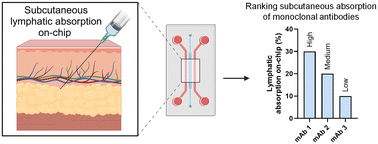The lymphatic vasculature plays a key role in the subcutaneous absorption of macromolecules (>16 kDa). Recent trends toward subcutaneous delivery of macromolecular therapeutics have brought awareness to the need for preclinical estimation of subcutaneous bioavailability prior to first-in-human studies. In vitro tools offer a low-cost means to inform molecule design and formulation and mitigate costly mistakes of under- or overestimation of therapeutic dose and exposure in clinical studies. Building on a previous engineered on-chip lymphatics platform, the utility of an in vitro model to rank therapeutic proteins based on lymphatic absorption was investigated. Lymphatics grown under a combination of interstitial flow and growth factor supplementation on-chip demonstrated in vivo-like morphology, phenotypic marker expression, and solute drainage rates after a 4-day culture period. Dextrans of increasing molecular weight were assessed on the model and demonstrated an inverse relationship between size and diffusion coefficient. Similarly, a reduced lymphatic transport on-chip was observed for large antibody aggregates compared to non-aggregated molecules. More importantly, lymphatic transport of a panel of nine therapeutic proteins and monoclonal antibodies successfully rank ordered these molecules based on their subcutaneous bioavailability in humans (Pearson r = 0.8929). The on-chip lymphatics model described here appears as a promising tool for rank ordering subcutaneous lymphatic absorption during early drug development to increase the potential for successful candidate selection moving toward the clinic.
